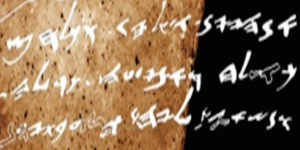
Researchers at Tel Aviv University use multispectral imaging technology were able to read additional letters and words in the existing inscription dating back almost 3,000 years, on one side of the clay, and to their surprise, three “new” lines appeared.
By Ilan Gattegno
Researchers at Tel Aviv University have uncovered a Hebrew inscription on a shard of pottery dating back to the First Temple era (the 11th to 5th centuries BCE) using new multispectral imaging technology, the “Plos One” multidisciplinary scientific journal reported Wednesday.
The shard, discovered decades ago, was believed to have been inscription-free on one side, but the multispectral imaging technology revealed it was used as part of a delivery of supplies to a military unit sent to Tel Arad, west of the Dead Sea.
“Every Arad inscription has been thoroughly studied since the 1960s, and some of them are regularly exhibited at the Israel Museum,” doctoral candidate Barak Sover said.
“We developed a new method of photography and re-examined the faded inscriptions to ensure the human eye didn’t miss anything. As it turns out, we discovered a brand new inscription that eluded experts for 50 years while it [the shard] was in the museum.”
Using the new multispectral imaging technology, researchers were able to read additional letters and words in the existing inscription on one side of the clay, and to their surprise, three “new” lines dealing with the delivery of supplies to a military unit became visible on its other side, previously considered “clean.”
Dr. Anat Mendel Geberovich, of the department of Archaeology and Ancient Near Eastern Civilizations at Tel Aviv University, explained that “the importance of this find doesn’t lie with text itself, but with the fact that we have very few First Temple-era texts and every additional mark provides us with a wealth of information.
“In these three lines and on the front of the inscription we identified new words that have so far been unfamiliar to researchers, as they don’t appear in the Bible,” she said.
In the early 1960s, archaeologist Yohanan Aharoni, formerly chairman of the Institute of Archaeology at Tel Aviv University, uncovered a trove of 91 pottery fragments in the Tel Arad Fortress — the largest corpus of Hebrew inscriptions dating back to the First Temple — believed to have been written on the eve of the Kingdom of Judah’s destruction by Babylonian King Nebuchadnezzar II.
The researchers now plan to use the new technology on all First Temple-era relics, saying that in the future multispectral photography will be an integral part of any new excavation.
View original Israel Hayom publication at:
http://www.israelhayom.com/site/newsletter_article.php?id=43145








 Israeli New Shekel Exchange Rate
Israeli New Shekel Exchange Rate